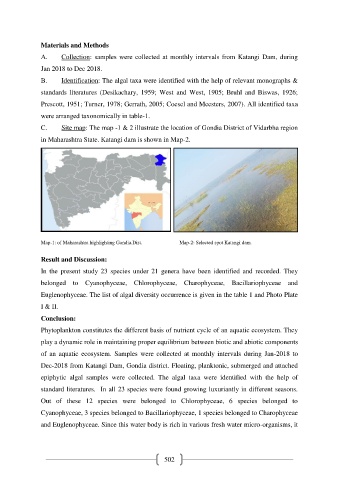Page 512 - e-Book
P. 512
Materials and Methods
A. Collection: samples were collected at monthly intervals from Katangi Dam, during
Jan 2018 to Dec 2018.
B. Identification: The algal taxa were identified with the help of relevant monographs &
standards literatures (Desikachary, 1959; West and West, 1905; Bruhl and Biswas, 1926;
Prescott, 1951; Turner, 1978; Gerrath, 2005; Coesel and Meesters, 2007). All identified taxa
were arranged taxonomically in table-1.
C. Site map: The map -1 & 2 illustrate the location of Gondia District of Vidarbha region
in Maharashtra State. Katangi dam is shown in Map-2.
Map-1: of Maharashtra highlighting Gondia.Dist. Map-2: Selected spot Katangi dam.
Result and Discussion:
In the present study 23 species under 21 genera have been identified and recorded. They
belonged to Cyanophyceae, Chlorophyceae, Charophyceae, Bacillariophyceae and
Euglenophyceae. The list of algal diversity occurrence is given in the table 1 and Photo Plate
I & II.
Conclusion:
Phytoplankton constitutes the different basis of nutrient cycle of an aquatic ecosystem. They
play a dynamic role in maintaining proper equilibrium between biotic and abiotic components
of an aquatic ecosystem. Samples were collected at monthly intervals during Jan-2018 to
Dec-2018 from Katangi Dam, Gondia district. Floating, planktonic, submerged and attached
epiphytic algal samples were collected. The algal taxa were identified with the help of
standard literatures. In all 23 species were found growing luxuriantly in different seasons.
Out of these 12 species were belonged to Chlorophyceae, 6 species belonged to
Cyanophyceae, 3 species belonged to Bacillariophyceae, 1 species belonged to Charophyceae
and Euglenophyceae. Since this water body is rich in various fresh water micro-organisms, it
502

